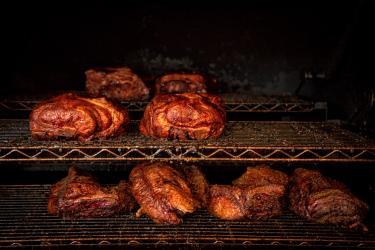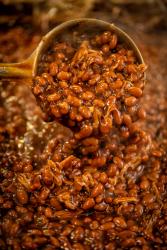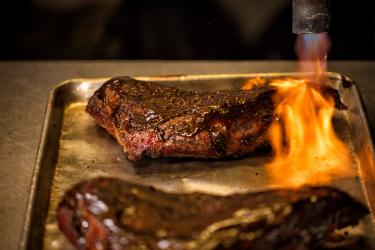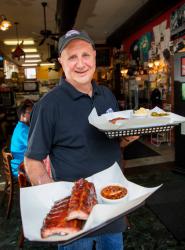Chef Michael Macchi (pronounced MOCK-ee) — just Macchi to his friends — has four decades of the food biz under his belt, but his 11 or so years at the pit at Bogart’s Smokehouse make him a relative newbie in the time-honored tradition of barbecue.
Let’s just say he’s a quick study. He’s been manning the smoker alongside owner and pitmaster Skip Steele since the restaurant’s beginnings in 2011 and the team has built it into a St. Louis-region institution.
Ribs and pit-baked beans are staples, and each has Bogart’s signature all over it. “There’s no other rib or bean anywhere that touches ours,” Macchi says. “First off, on the ribs we started with loin back rib. Everyone’s familiar with baby back. Loin back is a little bit bigger than spare ribs and a lot meatier rib, so we went with that.”
The rub spices and choice of smoking woods must play nice with the meat being smoked at any given time. “We like to stick with the milder woods, like the fruit woods. Right now, we’re using cherry wood. It seems to be readily available to us in the area and you kind of have to use what you have. Luckily it played in our favor.”
Those meats and that smoke affect the baked beans for which the Soulard smokehouse is famous. While Macchi’s bean-doctoring is vital, it’s really the cooking time and location of the legumes that matters most. “The beans cook on the same smoker as the beef brisket — 12 or 13 hours overnight — right under the brisket where they catch the drippings and some of the rub.”
Bogart’s singular take on steak is the tri-tip, a triangular cut of beef from the bottom sirloin, which gets a bit of smoke and flame in the cooking. Minimal, simple spicing let the steak flavor shine, while a brief period in the smoker gives it the requisite hint of smoke before it hits the grill to cook to medium-rare. Macchi uses a kitchen torch to sear the outside, brushes it with a house-made Asian barbecue sauce and torches it again to caramelize the sauce. This “short-short cook” takes 60 to 90 minutes — a nanosecond in the life of a pitmaster.
“A short cook is four or five hours. Overnight cooks are 12 to 24 hours. When you're trying anything new and experimenting and cooking overnight, it's hard. If it doesn’t work out, it’s back to square one. I even got to the point where I was locking the grill, so I wouldn't get into it.
“I’ve come to learn that I have got to have a lot more patience,” says Macchi, letting loose with a baritone laugh. “You have to love what you're doing and have a passion for it but also patience and a lot of practice. Barbecue is more of a craft than anything because you're always trying different methods, experimenting with different meats and spices and woods. Time and temperature are a big factor. Low and slow.”
Cooking School with Bogart’s Smokehouse
Learn secret hacks from the master himself, Michael Macchi, at the Cooking School on October 10 from 6:30-8:30 p.m. at Ferguson Bath, Kitchen and Lighting Gallery.
When: October 10, 6:30 – 8:30 p.m.
Cost: $35 per person
Where: Ferguson Bath, Kitchen and Lighting Gallery
17895 Chesterfield Airport Road, Chesterfield, MO 63005
RSVP by calling 636-230-9640, ext. 27 or email [email protected]
Or Reserve your seat online.
*Seating is limited.
Menu
Pit-Baked Beans: Students are free to start with a base of canned baked beans, which will be dressed up with molasses, brown sugar, chopped onion, salt, pepper, garlic and perhaps a dash of ketchup or chili or barbecue sauce. Macchi will teach cooking cheats you can use to add hints of smoke and beef flavors, such as time on the grill.
Ribs: A great rib rub includes spices like lemon pepper, thyme, smoked paprika, garlic, sugar, salt, cumin and a little cayenne. With indirect heat, good airflow and some patience — if one can muster it — the result is heavenly.
Tri-tip Steak: Chef Macchi will walk students through trimming the “silver skin” and an appropriate amount of fat from the top side to get just the right composition for grilling. “Then comes the fun part,” he says. “We bring out the torch.” Torch the meat and the sauce to crisp and caramelize, or simply finish on the hot side of the grill.
Fire and Ice Pickle: Cayenne hot sauce gives them fire, while the “ice” comes from the sweet syrup. This is a quick pickle but it’s even better the day after preparing.













